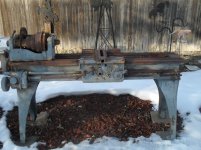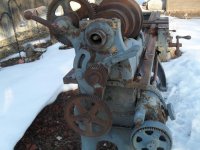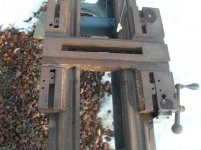vintagerestorer
Plastic
- Joined
- Jan 28, 2014
- Location
- Ogden Utah USA
Hello Everyone! I'm new to this site, and this is my first post. I have been reading some threads from this site that came up on Google searches the past couple weeks and have wanted to join. With this next project, I'm going to need some help and it seems this is the place to get it. So here is what I have..
Well I found the remains to what I believe is an old (1875-1905) Hamilton 14" lathe. I'm not sure about that, but that is my best guess.
I plan to get her up and running again, at least that's the plan.
I realize that I'll have a lot more money invested into this old heap than what the end result would be worth. But my plan after its done is not to sell, but to keep and use for other projects.
Now, I don't have Any experience running a metal lathe.. yet. I did purchase an old SB 9 inch a few weeks back. I think it's a model 415, but I need to check the serial number (62788) to know for sure. The SB lathe was working, but in need of a good tear down and cleaning. So that's what I'm doing right now. I was thinking of doing a thread on it, but I'm not sure how interested anyone would be on it. I started last night and hope to be done this weekend.
So this Hamilton is very incomplete. Its missing the tail stock, the entire apron and cross feed assembly, and the motor unit.
If anyone has any parts.. PLEASE let me know. Other than that, I'm thinking of making myself by casting new parts (which I have never done before). So even pictures of a Hamilton lathe would be very helpful. The more detailed the better.
As for the way I want to go. I'm not sure if I want to keep everything completely traditional and keep the machine configured in stock trim. On the extreme end, I'm envisioning a CNC with stepper motors (which I have no experience with). Like I stated, this is going to be a long project for me.
I'm really excited and the more I think about it the more I cant wait to get going with it. I really want to hold back and just clean up all the parts when I get them. I want to spend some time researching as much as I can. So any help and suggestions would be Greatly appreciated. I know its a big undertaking. But I was really interested in some Gingery Lathe projects I came across. This would be a big head start than going that route.
Thanks!
David
Well I found the remains to what I believe is an old (1875-1905) Hamilton 14" lathe. I'm not sure about that, but that is my best guess.
I plan to get her up and running again, at least that's the plan.
I realize that I'll have a lot more money invested into this old heap than what the end result would be worth. But my plan after its done is not to sell, but to keep and use for other projects.
Now, I don't have Any experience running a metal lathe.. yet. I did purchase an old SB 9 inch a few weeks back. I think it's a model 415, but I need to check the serial number (62788) to know for sure. The SB lathe was working, but in need of a good tear down and cleaning. So that's what I'm doing right now. I was thinking of doing a thread on it, but I'm not sure how interested anyone would be on it. I started last night and hope to be done this weekend.
So this Hamilton is very incomplete. Its missing the tail stock, the entire apron and cross feed assembly, and the motor unit.
If anyone has any parts.. PLEASE let me know. Other than that, I'm thinking of making myself by casting new parts (which I have never done before). So even pictures of a Hamilton lathe would be very helpful. The more detailed the better.
As for the way I want to go. I'm not sure if I want to keep everything completely traditional and keep the machine configured in stock trim. On the extreme end, I'm envisioning a CNC with stepper motors (which I have no experience with). Like I stated, this is going to be a long project for me.
I'm really excited and the more I think about it the more I cant wait to get going with it. I really want to hold back and just clean up all the parts when I get them. I want to spend some time researching as much as I can. So any help and suggestions would be Greatly appreciated. I know its a big undertaking. But I was really interested in some Gingery Lathe projects I came across. This would be a big head start than going that route.
Thanks!
David







